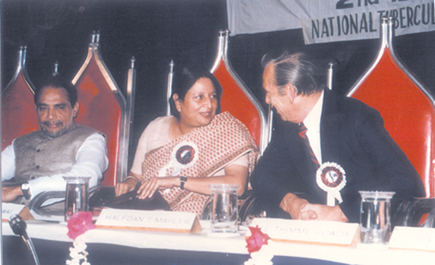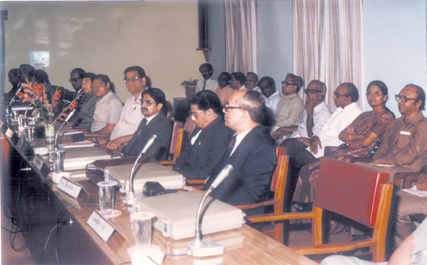4. THE WORK OF TWO DECADES
 Smt. Mohsina Kidwai, Union Minister for Health FW & others at the inaugural function, Silver Jubilee 1985 |
|
It is but natural that sometime...one has to seek an answer to the question, how far it has been possible to fulfill the purpose for which an institution was created... .The greatest contribution of the NTI has been to work out the modalities of an applicable programme... . What was possible for the NTI in 20 years of its existence was to generate and disseminate valuable information... However, what the NTI could not ensure, was to see that the users (i.e., the health agencies responsible for delivering health care) used the knowledge! In other words, the Institute had no means to effectively organise and supervise the use of the knowledge generated and distributed by it, simply because it was not the objective with which it was set up! AK Chakraborty |
|
|
4.1 The Tumkur district baseline studies
The great benefits sprouting from any work based on a long term vision takes time to germinate. Such work embodies well considered alternatives and the most pragmatic have better chances of being included. It would be necessary to engage in TB work along with sister concerns at the pace the community sets. Except that, the TB programme would set the direction, activate the community and accelerate the pace so that the vision articulated by the great minds designing and running the programme takes hold. In time, the programme will take roots in the community to slowly become the community’s own. There will be time to deliberate on the many possible ways for progression, understand the implications involved, consequences thereon and even plan for corrective measures. Best of all, hasty actions will be avoided. There will be an additional advantage: there will be plans for evaluation as an ongoing process.
There are many advantages in preferring such a view over the short term view, especially when planning for a nationally applicable control strategy. For e.g., time after time, anxious TB workers bring forth the TB detection camp idea. There are so many TB patients in the community waiting to be identified. Should one wait for the patients to turn up at the GHS to seek relief from the symptoms they are suffering? Why not organise TB detection camps fairly regularly to catch them early?
The idea is not without its own appeal and even tacit approval from the zealous. However, it is necessary to consider a few critical issues: the obduracy of TB as a disease; organising TB detection camps on countrywide basis; simple ways to utilise the available infrastructure without interfering in other programmes; good attendant diagnostic facilities; sustainable follow up system for treating patients thus detected; infrastructure to attend to the problems encountered in case holding; the perennial resource crunch, administrative bottlenecks... If we recollect the deficiencies and poor coverages of the mass BCG campaign approach, the camp idea buckles. It would naturally give way to the slow, reliable and ever widening approaches recommended under the NTP. The TB detection camp idea may have its rationale or urgencies but studies conducted revealed the other way. In Maharashtra 73 shibirs were conducted from 1969 to 1976 to improve case finding while in Karnataka from 1975 to 1976, a study of 25 camps were conducted91. It was found that these efforts may even boomerang and cause harm if adequate ongoing facilities were not provided. In 1989, Jagota and others conducted a study of camps for examining sputum of chest symptomatics attending out-patients of PHIs92. They found that only 16.3% of the referred symptomatics whose sputum samples were collected earlier actually turned up. More than two-third of the cases were missed as referrals did not turn up on the camp day. These findings do not undermine the educative value of camps. They can be conducted once in a while to help MOs at PHIs to select chest symptomatics but not as part of the NTP methodology92.
Another interesting example of incisive analysis can be found in the paper, validity of case finding tools in a NTP by Dr VH Balasangameshwara and Chakraborty93. For case finding in the DTP, the recommended method is sputum smear microscopy of patients with chest symptomatics attending health institutions on their own. There is a slight variation in the procedure of initial screening of out-patient attendance followed at the DTC and at the PHIs. At the DTC, patients with chest symptoms are first subjected to MMR (chest) and those with any abnormality are examined by smear microscopy. At the PHIs, all patients with chest symptoms are subjected to smear microscopy. PHIs do not have X-ray facility. The question is how much do these differences in the screening tools, matter in case finding? After thoroughly examining the data available from field surveys and from the DTP records, the authors opined: Examined in the context of statistical reliability of tests, the methodology of prior X-ray screening by the DTC for case finding TB appears to be well founded. In contrast to the DTC, the need for X-ray screening at PHIs does not arise, as the procedure of patients being subjected to screening for the presence of chest symptoms has in itself a very high specificity of 97%..... X-ray and smear microscopy should not be used indiscriminately as case finding tools in mass active case finding programmes. Their predictive values of positivity are likely to be very low at the current case prevalence rates in the community, which are in the range of 2-8 per thousand93.
Suffice it to say that the NTP has well chiseled, long term considerations. It has to cater to the entire nation. Therefore, it has to take into account several related aspects. For e.g., TB is not a short term disease. It is not also concentrated in a few identifiable pockets. The disease now is chronic, slow or indolent, fibrotic, not so fatal and prevalent more among the elderly87. Described as the shooting star phenomenon, patients continuously show up from the vast pool of the infected as if from out of the blue. Repeat surveys show that fresh cases of the second survey come up mostly from the X-ray normals and some from the X-ray abnormals of the second survey. There is considerable auto-healing and deaths that almost matches with the number of patients breaking down into disease annually. Experts hold the view that environmental and socio-economic conditions play such a key role that it is perhaps difficult to fight TB by programme alone94. The programme must take all these and other key factors like available infrastructure support and people’s perspectives in its reckoning. Further, any programme however well researched is likely to develop operational difficulties while functioning. There must be an in-built ongoing mechanism for modifying it to find durable solutions. There must also be periodic scrutiny and evaluation so that the programme stays fine tuned. This underscores the importance of the enduring views steadfastly nurtured by the NTI in all aspects of its work including training and research.
